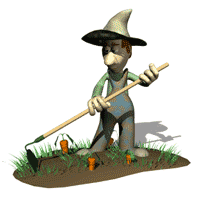  |
  |


Planting a vegetable garden at home can be fun, economical, and educational, but it can also be quite frustrating if you donít do some planning and preparation. Here are some ideas to get you started, check with your local Cooperative Extension for more tips.
First you should plan out your garden. One thing you will want to consider for a home vegetable garden is sunlight. Vegetable crops need a lot of sun, about six hours of full sunlight a day. For convenience, placing your garden near your water source, and near your house are good ideas as well, if possible. Draw a chart of your garden and plan out what crops will go where. If this is your first try at vegetable gardening, it is a good idea to start small so you can see how much time and work it will require. Plant crops that your family really likes in quantities that will be manageable to grow and use.
If you want good crops, you need good soil. Preparing your garden bed is the next step to a successful garden. Some preparation in the fall, like tilling, or loosening up the soil, will make it easier to get ready in the spring and will allow you to start some plants out earlier. For optimal results, have your soil tested to see if it is acidic, what nutrients it has, etc. This will help you decide how and how much to fertilize your garden. If you donít want to have your soil tested, ask the local gardening or seed store about local conditions. They should be able to give you a good idea of what is typical in your area. When you fertilize, pay close attention to recommended amounts and ratios of fertilizer to soil or size of your garden bed. Too much fertilizer will burn and kill your plants.
Now you can lay out your garden. Use stakes and string to create straight rows so you will know where your seeds are before they come up. Put up wire hoops or trellises for tomatoes, beans, and other plants that climb. Make soil mounds for tender vine crops like cucumbers and pumpkins. Whether you are planting seeds or plants that you have purchased or started indoors, make sure that you leave enough space between plants so they can get adequate sunlight, and not be competing with their neighbors for water and soil nutrients.
With a little forethought, you can end up with an enjoyable hobby that feeds your family, too!

| © RIYAN Productions |